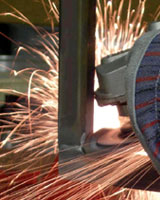Composite Fabrication Jobs
Composite fabrication jobs involve a variety of manufacturing processes. The specific processes used are dictated by the product's characteristics. Composite fabrication jobs utilize multiple materials that are distinguishable yet work together to create durable products. Because of the multitude of materials that can be used, there are numerous fabrication methods for making composite products.
Composition Fabrication Jobs: Protrusion
The pultrusion uses a molding process that is continuous. Pultrusion combines thermosetting resin and fiber reinforcements for composite fabrication jobs. This process is useful for composite materials with cross-section profiles, such as bar sections, rods, tool handles, electrical cable trays, ladder side rails, decks and bridge beams. Other materials that require pultrusion composite fabrication jobs include pultruded laminates, strand mats and braided, knitted and woven fabrics.
Composition Fabrication Jobs: Resin Transfer Molding and Vacuum Assisted Resin Transfer Molding
Another process used in composite fabrication jobs is resin transfer molding, or RTM. This process is also known as the closed mold process. Reinforced material is situated between two identical mold surfaces. After the set of molds are closed and clamped, low-viscosity thermostat resin will be injected under pressures ranging from 50-100 PSIs. This resin is put into the cavity of the molds through ports. After all of the voids are filled, the resin penetrates every portion of the materials' surface.
There are various fibers used in resin transfer molding. Some common forms include woven or mat constructions, continuous fibers and hybrid fibers with multiple fibers infused within the material. In some cases, fabricators will use vacuums to boost the flow of resin and reduce the formation of voids. Afterwards, the material is treated with heat. There are other applications that can be properly cured with exothermic resin reactions.
Resin transfer molding requires the usage of a matching, closed mold set, which is also an aspect of vacuum assisted resin transfer molding, or VASRTM, composite fabrication jobs. In order to increase production times, fiber reinforcements are made off line. Resin is infused at high pressures and a vacuum is also used. VASRTM is utilized in the manufacturing of both thick and thin laminates. This process is also ideal for complex shapes that have unique fiber characteristics.
Composition Fabrication Jobs: Open Molding and Compressed Molding
Two other process are used in composite fabrication jobs: open molding and compressed molding. In order to form a single laminate by bonding multiple laminates, open molding is performed. The mechanical properties and material types will vary. There are also different properties in terms of wood and other composites.
When it comes to molding thermosetting materials, compression molding is most commonly utilized. This process is best suited for composite fabrication jobs that use bulk molding compounds, or BMCs, and sheet molding compounds, or SMCs. The materials are compressed with a vertical press in heat-matched metal dyes containing temperature-activated catalysts.
Composition Fabrication Jobs: Filament Winding
Filament winding is integral for tubular composite fabrication jobs. Composite pipes, composite tanks and electrical conduits are the most common products made by filament winding. Liquid thermosetting resin is injected into fiberglass roving strands, which are wrapped around a rotating mandrel. Then, the resin is polymerized and the composite material is removed.

